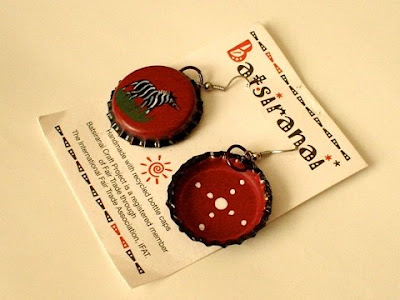
We went window-shopping last friday and found one of those "mall islands" with handcrafted items from Africa. They had a 50% discount on everything, so of course I ended up with another mask for my collection. It's just terrible for the pocket when there are so many nice things in one store. While we waited for the cashier lady to attend other customer, we grabbed more items... and even as she was wrapping our things we bought a set of earrings. Those earrings are particularly interesting, they are made out of old fashioned tin bottle caps ... nowadays most bottles come with those horrible
"taparoscas" (plastic caps).
I remember when
"corcholatas" actually had a cork ring inside. It was a challenge to get the ring out of the cap, but the reward for a bit of patience was a nice item to play with. I don't think the new plastic caps have the same hypnotizing effect on children anymore. I also remember that sometimes they had pictures for collecting. Like for example pictures of the national Mexican soccer ball team, which you could glue into a cardboard and exchange with your classmates. Of course there's always the one that is hard to get, and you would trade it for a lot of the common ones. A collection like that should cost a lot more than a few bottle caps nowadays. I just found a 2005 coca-cola bottle, not a special edition or anything... and it's
worth 100 pesos!!! I will definitely call the insurance company first thing in the morning to get an appraisal of my bottles collection... specially those with
the 1950's pepsi logo that resembled the coca cola logo.
Anyway, back to the earrings, they are part of a project called
"Batsiranai" which means "helping each other":
 Batsiranai (BAT-si-RA-nai) is a women’s handicraft project that supports mothers with severely disabled children living under challenging circumstances in Harare, Zimbabwe. In addition to living with extreme poverty, these families often suffer from stigma related to local beliefs regarding the origin of disabilities. In addition to stigmatization, 25% of the Zimbabwean population is living positively with HIV. Thus, in Zimbabwe there is much opportunity for “helping each other.”
Batsiranai (BAT-si-RA-nai) is a women’s handicraft project that supports mothers with severely disabled children living under challenging circumstances in Harare, Zimbabwe. In addition to living with extreme poverty, these families often suffer from stigma related to local beliefs regarding the origin of disabilities. In addition to stigmatization, 25% of the Zimbabwean population is living positively with HIV. Thus, in Zimbabwe there is much opportunity for “helping each other.”
The mother's group initiative has been so successful, that it
inspired a group of fathers to start a similar venture:
The ‘fathers group’ began meeting in December 2004. In the group’s first meetings, the men were interested in how they might reduce the stigma surrounding people living with disabilities. Disabilities are poorly understood in Zimbabwe, and it is not uncommon for a father to abandon his wife and newborn child when the child has a disability -- blaming either the wife or voodoo for this 'defect.' This 'shameful' view of disabilities is often shared by extended family and the surrounding community.

Those earrings are a beautiful product on so many levels. Of course the hand painting and design is superb. What I personally like the most is the noise they make, it sounds... well, like bottle caps! That brings back memories of the times when we
played with those things. I guess our perception of simple feelings and sounds gets spoiled with modern life... that's why so many people set their digital cameras to make the noise of mechanic cameras, some people enable their computer keyboards to make the noise of a typewriter, etc. The transformation of a discarded object into a
piece of jewelery is fantastic. And the fact that a community is doing all that to get better opportunities for their disabled children, just closes the full circle.

How can we be so obsessed and distracted with gadgets, celebutantes and infotainment when there are many simple things that are so powerful? Why are so many blogs
reporting on the latest coolhunting gizmo? which is just empowering big electronic corporations, whilst so few talk about projects which empower actual people: congratulations to Mai Paul, Mai Munashe, Baba Mutsa, Baba Sipaphile, Baba Precious and all those mothers and fathers (and
of course George too) for their stupendous job, and best of luck!
ciao



























































